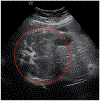Accuracy of estimated fetal weight assessment in fetuses with abdominal wall defects
- PMID: 33895400
- PMCID: PMC8328936
- DOI: 10.1016/j.ajogmf.2021.100385
Accuracy of estimated fetal weight assessment in fetuses with abdominal wall defects
Abstract
Background: Gastroschisis and omphalocele are congenital abdominal wall defects in which the bowel and other abdominal contents extrude from the fetal abdominal cavity. Standard formulas for estimated fetal weight using ultrasound include fetal abdominal circumference measurement and have a range of error of approximately 10%. It is unknown whether the accuracy of estimated fetal weight assessment is compromised in fetuses with abdominal wall defects because of the extrusion of abdominal contents.
Objective: This study aimed to assess the accuracy of standard estimated fetal weight assessment in fetuses with abdominal wall defects by comparing prenatal assessment of fetal weight with actual birthweight.
Study design: A retrospective cohort study of fetuses diagnosed with gastroschisis or omphalocele was performed at a single center from 2012 to 2018. Fetuses with additional anomalies or confirmed chromosome abnormalities were excluded. Estimated fetal weight was calculated using the Hadlock formula. Published estimates of fetal growth rate were used to establish a projected estimated fetal weight at birth from the final growth ultrasound, and the percent difference between projected estimated fetal weight at birth and actual birthweight was calculated. The Wilcoxon rank-sum test was used to examine the difference between projected estimated fetal weight and actual birthweight.
Results: We had complete data for 112 fetuses with abdominal wall defects, including 85 with gastroschisis and 27 with omphalocele. The median (interquartile range) projected estimated fetal weight was similar to median birthweight, at 2283 g (interquartile range, 2000-2810) and 2306 g (interquartile range, 1991-264), respectively, which did not represent a statistically significant difference between projected estimated fetal weight and actual birthweight (P=.32). The median percent error was 6.8 (3.1-12.8). In addition, we did not find any statistical difference between projected estimated fetal weight and actual birthweight in patients with gastroschisis (P=.52) or omphalocele (P=.35) individually. Estimated fetal weight was underestimated in most cases (n=68 [60.7%]).
Conclusion: In fetuses with abdominal wall defects, standard measurement of fetal weight shows an accuracy that is at least comparable with previously established margins of error for ultrasound assessment of fetal weight. Standard estimated fetal weight assessment remains an appropriate method of estimating fetal weight in these fetuses.
Keywords: abdominal circumference; fetal anomalies; fetal biometry; fetal growth; gastroschisis; omphalocele; ultrasound.
Copyright © 2021 Elsevier Inc. All rights reserved.
Conflict of interest statement
The authors report no conflict of interest.
Figures


Similar articles
-
Accuracy of estimated fetal weight assessment in fetuses with congenital diaphragmatic hernia.Am J Obstet Gynecol MFM. 2020 Feb;2(1):100064. doi: 10.1016/j.ajogmf.2019.100064. Epub 2019 Nov 9. Am J Obstet Gynecol MFM. 2020. PMID: 33345980
-
Fetal abdominal wall defects in an Australian tertiary setting: contemporary characteristics, ultrasound accuracy, and outcome.J Matern Fetal Neonatal Med. 2021 Apr;34(8):1269-1276. doi: 10.1080/14767058.2019.1633303. Epub 2019 Jun 26. J Matern Fetal Neonatal Med. 2021. PMID: 31242785
-
Accuracy of sonographic estimation of weight in fetuses with abdominal wall defects.Aust N Z J Obstet Gynaecol. 2020 Oct;60(5):766-772. doi: 10.1111/ajo.13162. Epub 2020 Apr 14. Aust N Z J Obstet Gynaecol. 2020. PMID: 32291746
-
Magnetic resonance imaging for prenatal estimation of birthweight in pregnancy: review of available data, techniques, and future perspectives.Am J Obstet Gynecol. 2019 May;220(5):428-439. doi: 10.1016/j.ajog.2018.12.031. Epub 2018 Dec 22. Am J Obstet Gynecol. 2019. PMID: 30582928 Review.
-
Fetal abdominal wall defects.Best Pract Res Clin Obstet Gynaecol. 2014 Apr;28(3):391-402. doi: 10.1016/j.bpobgyn.2013.10.003. Epub 2013 Dec 3. Best Pract Res Clin Obstet Gynaecol. 2014. PMID: 24342556 Review.
References
-
- Kirby RS. The prevalence of selected major birth defects in the United States. Semin Perinatol 2017;41:338–44. - PubMed
-
- St Louis AM, Kim K, Browne ML, et al. Prevalence trends of selected major birth defects: a multi-state population-based retrospective study, United States, 1999 to 2007. Birth Defects Res 2017;109:1442–50. - PubMed
-
- Juhasz-Böss I, Goelz R, Solomayer EF, Fuchs J, Meyberg-Solomayer G. Fetal and neonatal outcome in patients with anterior abdominal wall defects (gastroschisis and omphalocele). J Perinat Med 2011;40:85–90. - PubMed
-
- Hadlock FP, Harrist RB, Sharman RS, Deter RL, Park SK. Estimation of fetal weight with the use of head, body, and femur measurements–a prospective study. Am J Obstet Gynecol 1985;151:333–7. - PubMed
Publication types
MeSH terms
Grants and funding
LinkOut - more resources
Full Text Sources
Other Literature Sources

